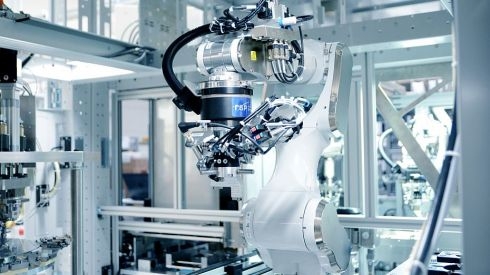Electrolysis companies need to rapidly expand their manufacturing capacities to meet the fast-growing demand for green hydrogen production. To prepare the serial, automated production of Sunfire’s alkaline and SOEC electrolyzers, the company and its affiliated partners from industry and research are receiving grant funding from the Federal Government.
Dresden, January 6, 2022 | Thanks to its potential for decarbonizing energy-intensive industries, green hydrogen has evolved from a contentious “new hope” to a fixed building block of the energy transition. It is no surprise then that demand is rocketing for electrolyzers, which split water into hydrogen using renewable electricity. According to the plans, installed capacity in the EU alone is set to rise from the current 0.2 GW to 40 GW by 2030.
Against this background, Sunfire – one of the world’s leading developers and producers of electrolyzers – is rapidly expanding its manufacturing capacities. Together with partners from research and industry, the German-based company is preparing its technologies for industrial production at gigawatt scale. To this end, the Federal Ministry of Education and Research (BMBF) is providing a grant of EUR 60 million for the lead project H2Giga.
The funding commitment will accelerate time-to-market of innovative high-temperature electrolyzers (SOEC). Under the leadership of Sunfire, 15 associated partners will be receiving EUR 33 million to establish manufacturing processes and optimize systems. By using off-heat from industrial processes, Sunfire’s SOEC electrolyzers require up to 30 % less electricity from renewable energy sources than other technologies to produce a kilogram of hydrogen. “
The new generation of our SOEC technology will be even more powerful and durable than today,” announced Christian von Olshausen. “We will redesign individual components to last longer and we will simplify the design of the systems,” added the Sunfire CTO. “With our optimized high-temperature electrolyzers, our industrial customers will be able to produce green hydrogen more efficiently – and therefore more cost-effectively. To further reduce the price of our product, we will be developing process chains for industrial series production.”
Sunfire is embarking on the challenging path to gigawatt-scale production together with several partners the company has already been working with on various projects in the past. For example, the company will be drawing on the expertise of XENON Automatisierungstechnik GmbH to help set up a pilot line for automated production. Both companies are already collaborating in making SOEC electrolyzers for the refinery of fuel producer Neste in Rotterdam.
“We are really happy to cooperate with partners like XENON. They offer invaluable experience in the field of industrial manufacturing and are open to contributing this expertise to help drive the development of new technologies,” explained Christian von Olshausen.
But the development of SOEC technology is not the sole target of support: BMBF is also providing funding for the industrialization of pressurized alkaline electrolyzers. Although these robust systems have already proved themselves for decades in industrial hydrogen projects, they have not yet been manufactured in series production. Sunfire and its eight associated partners have been granted total funding of EUR 27 million to transform the production of this technology to gigawatt scale.
“We will be establishing manufacturing processes and finalizing the new design of our pressurized alkaline electrolyzers,” explained Christian von Olshausen. “In comparison to the predecessor models, these will be yet another step forward in terms of energy consumption and longevity.”
This will give a further boost to the process of alkaline electrolysis – which is already well established as the most cost-effective electrolysis technology currently available.
The commitment from the German Government under the program “Wasserstoffrepublik Deutschland” (The Hydrogen Republic of Germany) is designed to accelerate the development and expansion of technologies to enable energy-intensive industries to produce and use green hydrogen fast and at scale. In the lead project H2Giga, around 30 independent alliances are now working on transforming electrolysis technologies to the gigawatt scale. In addition to the public funding, Sunfire will also be investing significant amounts of its own funds in the industrialization process.

Partners SOEC
Partners Alkaline
Picture: Copyright XENON
Sunfire is a global leader in the production of industrial electrolyzers based on pressurized alkaline and solid oxide (SOEC) technologies. With its electrolysis solutions, Sunfire is addressing a key challenge of today’s energy system: Providing renewable hydrogen and syngas as climate-neutral substitutes for fossil energy. Sunfire’s innovative and proven electrolysis technology enables the transformation of carbon-intensive industries that are currently dependent on fossil-based oil, gas, or coal. The company employs more than 650 people located in Germany and Switzerland.
For more information visit www.sunfire.de